Thursday, November 26, 2009
Song of the Day: By Divine Right - Hugger of Trees
By Divine Right to release first album in five years!
http://www.exclaim.ca/articles/generalarticlesynopsfullart.aspx?csid2=844&fid1=42588&csid1=0
Wednesday, November 25, 2009
Song of the day: The White Stripes - There's No Home For You Here
There's no home for you here
I'd like to think that all of this constant interaction
Is just the kind of make you drive yourself away
Each simple gesture done by me is counteracted
And leaves me standing here with nothing else to say
Completely baffled by a backward indication
That an inspired word will come across your tongue
Hands moving upward to propel the situation
Have simply halted
And now the conversation's done
There's no home for you here girl, go away
There's no home for you here
I'm only waiting for the proper time to tell you
That it's impossible to get along with you
It's hard to look you in the face when we are talking
So it helps to have a mirror in the room
I've not been really looking forward to the performance
But there's my cue and there's a question on your face
Fortunately I have come across an answer
Which is go away
And do not leave a trace
There's no home for you here girl, go away
There's no home for you here
Waking up for breakfast
Burning matches
Talking quickly
Breaking bubbles
Throwing garbage
Drinking soda
Looking happy
Taking pictures
So completely stupid
Just go away
There's no home for you here girl, go away
There's no home for you here
...
When I first copies the lyrics for here, the "Breaking bubbles" lyric (as appears on the official website) was "breaking baubles". What the heck are baubles?
Christmas ornaments!

http://en.wikipedia.org/wiki/Bauble
I feel like I've been falling behind my music here a bit. Time to spin the black circle for a bit tonight, before Calgary.
Monday, November 23, 2009
Part of the Alex Anthopoulos/Paul Beeston plan...

(this is still the only photo I've ever seen of the dude)
http://msn.foxsports.com/mlb/story/10416132/Blue-Jays-bring-in-more-scouts-to-help-fill-roster
Alex Anthopoulos, the Blue Jays' new general manager, is increasing the team's number of domestic scouts from 28 to 54 in an attempt to better compete with the Yankees and Red Sox in the AL East.
Anthopolous, 32, is no old-school throwback, longing for the days when teams relied solely on scouts' opinions and not computers. Quite the contrary. He grew up reading Bill James, believes in blending subjective and objective analysis, and uses Tom Tango, a leading sabermetrician, as a consultant.
His increased emphasis on scouting, while more retro than radical, is certainly a departure from the current trend. But Anthopoulos sees it like this: So many clubs employ statistical analysis, the numbers no longer offer as significant a competitive advantage.
Scouts — good scouts — might offer more of an edge.
...
If the Jays reduce an area scout's region from, say, six states to three, the scout can dig deeper into his list of players, see a hitter for perhaps 20 at-bats instead of four, a pitcher for perhaps 15 innings instead of three.
...
The Jays, seeking more and better information, are increasing their number of pro scouts from 10 to 15. All but one will cover two organizations each, top to bottom, majors to rookie ball (the other will cover one club).
Scotch on the rocks
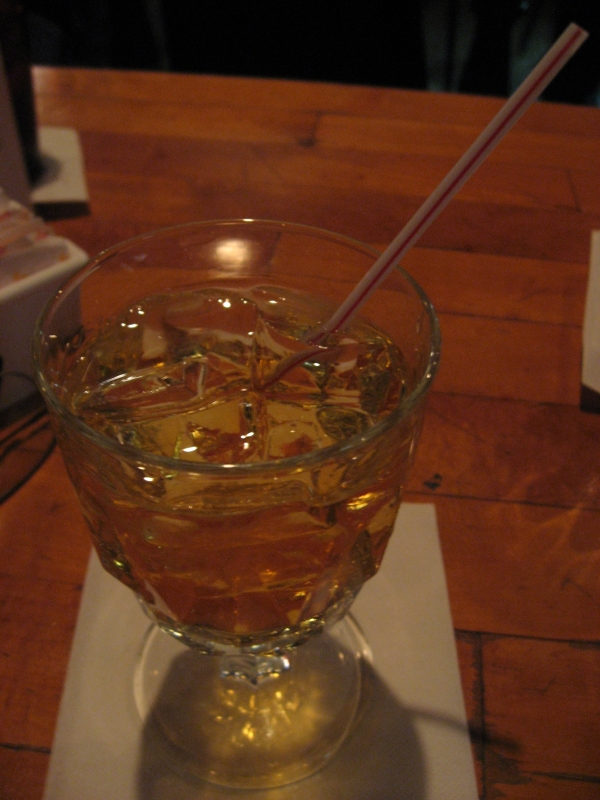
(Scotch, drilled to the bottom)
Ernst Shackleton's antarctic adventures: In January 1909 he and three companions made a southern march which established a record Farthest South latitude at 88°23'S, 97 geographical miles (114 statute miles, 190 km) from the South Pole, by far the closest convergence in exploration history up to that time. For this achievement, Shackleton was knighted by King Edward VII on his return home.
After the race to the South Pole ended in 1912 with Roald Amundsen's conquest, Shackleton turned his attention to what he said was the one remaining great object of Antarctic journeying—the crossing of the continent from sea to sea, via the pole. To this end he made preparations for what became the Imperial Trans-Antarctic Expedition, 1914–17. Disaster struck this expedition when its ship, Endurance, was trapped in pack ice and slowly crushed, before the shore parties could be landed. There followed a sequence of exploits, and an ultimate escape with no lives lost, that would eventually assure Shackleton's heroic status (via Wikipedia)
(via Boingboing)

So, in 1909 Shackleton aborted the attempt to reach the South Pole (no, he really just wanted to stop 200 kms outside the south pole). While there he abandoned two cases of scotch at base camp. A century later someone is digging it up.
Whyte & Mackay, the drinks group that now owns McKinlay and Co., has asked for a sample of the 100-year-old scotch for a series of tests that could decide whether to relaunch the now-defunct Scotch. Workers from New Zealand's Antarctic Heritage Trust will use special drills to reach the crates (a straw), frozen in Antarctic ice under the Nimrod Expedition hut near Cape Royds.
If you haven't seen the movie about this antarctic excursion, you really should. The Endurance came as a bit of a surprise, and after seeing it a few times (once just recently) it was really well done.
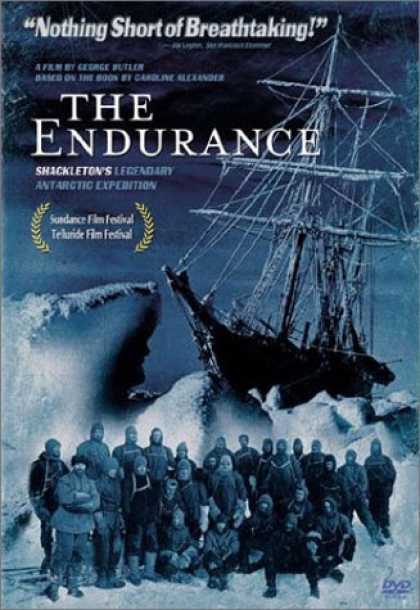
Here's the NyTimes review and Metacritic, with universal acclaim.
Sunday, November 22, 2009
So, why is yawning contagious?
What intrigues me most about laughter is how it spreads. It’s almost impossible not to laugh when everybody else is. There have been laughing epidemics, in which no one could stop and some even died in a prolonged fit. There are laughing churches and laugh therapies based on the healing power of laughter. The must-have toy of 1996—Tickle Me Elmo—laughed hysterically after being squeezed three times in a row. All of this because we love to laugh and can’t resist joining laughing around us. This is why comedy shows on television have laugh tracks and why theater audiences are sometimes sprinkled with “laugh plants”: people paid to produce raucous laughing at any joke that comes along.
The infectiousness of laughter even works across species....
Shared laughter is just one example of our primate sensitivity to others. Instead of being Robinson Crusoes sitting on separate islands, we’re all interconnected, both bodily and emotionally. This may be an odd thing to say in the West, with its tradition of individual freedom and liberty, but Homo sapiens is remarkably easily swayed in one emotional direction or another by its fellows.
This is precisely where empathy and sympathy start—not in the higher regions of imagination, or the ability to consciously reconstruct how we would feel if we were in someone else’s situation. It began much more simply, with the synchronization of bodies: running when others run, laughing when others laugh, crying when others cry, or yawning when others yawn. Most of us have reached the incredibly advanced stage at which we yawn even at the mere mention of yawning—as you may be doing right now!—but this is only after lots of face-to-face experience.
Yawn contagion, too, works across species. Virtually all animals show the peculiar “paroxystic respiratory cycle characterized by a standard cascade of movements over a five- to ten-second period,” which is the way the yawn has been defined. I once attended a lecture on involuntary pandiculation (the medical term for stretching and yawning) with slides of horses, lions, and monkeys—and soon the entire audience was pandiculating. Since it so easily triggers a chain reaction, the yawn reflex opens a window onto mood transmission, an essential part of empathy. This makes it all the more intriguing that chimpanzees yawn when they see others do so.
Yawn contagion reflects the power of unconscious synchrony, which is as deeply ingrained in us as in many other animals. Synchrony may be expressed in the copying of small body movements, such as a yawn, but also occurs on a larger scale, involving travel or movement. It is not hard to see its survival value. You’re in a flock of birds and one bird suddenly takes off. You have no time to figure out what’s going on: You take off at the same instant. Otherwise, you may be lunch.
Or your entire group becomes sleepy and settles down, so you too become sleepy. Mood contagion serves to coordinate activities, which is crucial for any traveling species (as most primates are). If my companions are feeding, I’d better do the same, because once they move off, my chance to forage will be gone. The individual who doesn’t stay in tune with what everyone else is doing will lose out like the traveler who doesn’t go to the restroom when the bus has stopped.

Also, does susceptibility to others' yawning mean you're a nicer person (empathy and all.. )?
Ok, one more iphone app/board game: Settlers of Catan

Here's a review of the iphone game, and here's a pretty good strategy site.
Basically, you can read the rules here, but in all honesty, I didn't understand the game until playing 4-5 times. Getting started, the game tutorial does help a bit as well.
Also, I think cuz the rules are built in very strict on the app, it's easier not to make stupid addition mistakes, placement mistakes, not seeing the big picture mistakes. I'm looking forward to playing with others to see how different it is..
The only downside to this app that I see is the multi-player; there's no wifi or bluetooth option, so that means you're gonna be passing the iphone around, which is bogus. Time to make a board over the Christmas holidays.

Saturday, November 21, 2009
Timelapse app for iphone
http://philipbloom.co.uk/2009/11/21/itimelapse-app-for-your-iphone-yes-really/
Here's an example timelapse movie!
Also, the best iphone stand I've seen, made from a paperclip.
A Case for Working With Your Hands

http://www.nytimes.com/2009/05/24/magazine/24labor-t.html
When we praise people who do work that is straightforwardly useful, the praise often betrays an assumption that they had no other options.
We idealize them as the salt of the earth and emphasize the sacrifice for others their work may entail. Such sacrifice does indeed occur — the hazards faced by a lineman restoring power during a storm come to mind. But what if such work answers as well to a basic human need of the one who does it? I take this to be the suggestion of Marge Piercy’s poem “To Be of Use,” which concludes with the lines “the pitcher longs for water to carry/and a person for work that is real.” Beneath our gratitude for the lineman may rest envy.
...
There is a pervasive anxiety among parents that there is only one track to success for their children.
...
The trades suffer from low prestige, and I believe this is based on a simple mistake. Because the work is dirty, many people assume it is also stupid. This is not my experience.
...
There probably aren’t many jobs that can be reduced to rule-following and still be done well. But in many jobs there is an attempt to do just this, and the perversity of it may go unnoticed by those who design the work process ... Any given symptom may have several possible causes, and further, these causes may interact with one another and therefore be difficult to isolate. In deciding how to proceed, there often comes a point where you have to step back and get a larger gestalt. Have a cigarette and walk around the lift. The gap between theory and practice stretches out in front of you, and this is where it gets interesting. What you need now is the kind of judgment that arises only from experience; hunches rather than rules. For me, at least, there is more real thinking going on in the bike shop than there was in the think tank.
...
I once accidentally dropped a feeler gauge down into the crankcase of a Kawasaki Ninja that was practically brand new, while performing its first scheduled valve adjustment. I escaped a complete tear-down of the motor only through an operation that involved the use of a stethoscope, another pair of trusted hands and the sort of concentration we associate with a bomb squad. When finally I laid my fingers on that feeler gauge, I felt as if I had cheated death. I don’t remember ever feeling so alive as in the hours that followed.
Often as not, however, such crises do not end in redemption. Moments of elation are counterbalanced with failures, and these, too, are vivid, taking place right before your eyes. With stakes that are often high and immediate, the manual trades elicit heedful absorption in work. They are punctuated by moments of pleasure that take place against a darker backdrop: a keen awareness of catastrophe as an always-present possibility. The core experience is one of individual responsibility, supported by face-to-face interactions between tradesman and customer.
...........................................................................
Sometimes I really like my job for this reason. If I get bored in the office and feel the need to work with my hands, I can go down to the garage and observe, tinker, lend a (very novice) helping hand, hang out and learn the ins and outs of an isolated system being currently worked on (a gas pump failure, vehicle overheating, vacuum leaks, etc.). Beyond the learning, there is a certain immediate gratification with every small step you take while working with your hands. Whether it's drilling down a line of steel bolts, cutting up stainless steel at step 1 of a project, or suggesting a solution to a mechanical problem that hasn't yet been thought of because you're really just an outside eye; there is a certain immediate gratification that is not reached when pressing save and send on a spreadsheet. Then, I can go back into the office, sort of refreshed (perspective?), and continue at the desk doing desk stuff.
Writing invoices, preparing ad campaigns, researching tech, gathering/organizing statistical information, government bs, payroll, cheques, organizing schedules, preparing for operations, etc.; soft skills? There really isn't an immediate satisfaction. The variety is certainly there, but something is definitely not. Maybe, more specifically, it's an immediate recognition of your worth. I think that's part of the reason I like work road trips so much. At the end of the trip I know exactly how much I made and saved the company. Granted I spend 95% of my time at the desk, but if it wasn't for that 5% in the garage and on the road, I most certainly wouldn't still be at the PHD Group.
Friday, November 20, 2009
Yes, yes, but is your book available in Braille?
The Braille system is a method that is widely used by blind people to read and write. Braille was devised in 1821 by Louis Braille, a blind Frenchman (Wikipedia). Each Braille character or cell is made up of six dot positions, arranged in a rectangle containing two columns of three dots each.
As originally conceived by Louis Braille, a sequence of characters, using the top four dots of the Braille cell, represents letters a through j. Dot 3 is added to each of the a through j symbols to give letters k through t. Both of the bottom dots (dots 3 and 6) are added to the symbols for "a" through e to give letters u, v, x, y, and z. The letter w is an exception to the pattern because French did not make use of the letter "w" at the time Louis Braille devised his alphabet, and thus he had no need to encode the letter "w".

(potential) new Braille technology:

A Braille wristwatch?

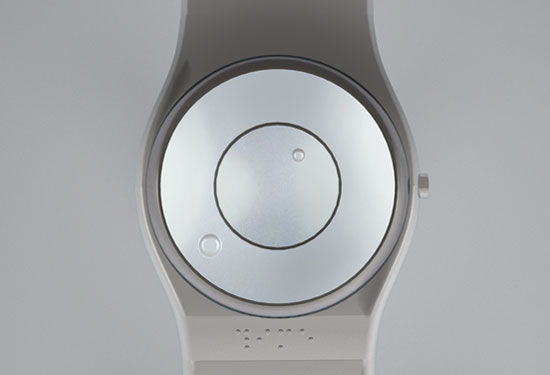
BabelBraille?
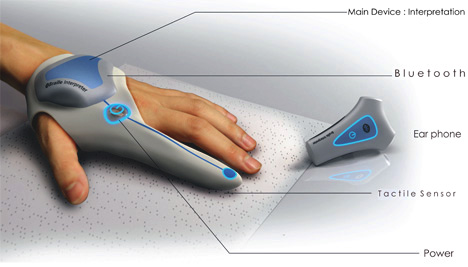
Or, better yet, learn to write in Braille for a cheaper printer!

UofT technology?!
There's also the traditional Braille desktop embosser printers (to translate, say, a Microsoft Word document into Braille).

How about saving the paper and having a Braille E-book reader?

http://www.engadget.com/2009/03/31/researchers-develop-braille-for-vibrating-touchscreen/

Ummm, is it just me, or is there absolutely no point to have this thing so big? Couldn't the Braille E-book reader be the size of only one or two cells? Just have them refreshing at a rate controlled constant by the reader? Sort of like an morse code signal but more space-time efficient? This would be a fantastic way to miniaturize any book. Time to start learning Braille...
I suppose this idea (of having the page move under the finger, and not vice-versa) could technically apply to a traditional E-book reader as well. Perhaps this was already tried? There must be (?) a psychological familiarity thing intertwined with the "old technology" of a page of words presented infront of you, rather than having them spin and change under your stationary eyes...
Bike redesign

Wytze says that “it is maintenance free, it has an efficiency of 96% (compared to 98% chain efficiency). It works.” The hole in the bottom bracket is visually striking, but it had another purpose in the design; “it is the legacy of the idea to give the customer the option to fit the bike aftermarket with an electric pedal assist.
http://bicycledesign.blogspot.com/2009/11/cannondale-dutchess-follow-up.htm
How does the LHC actually look?
The Boston.com has some fantastic photos.

The second best way around...

Detail of some of the damage done to the LHC magnets in sector 3-4 on September 19th, 2008. (Maximilien Brice, © CERN)

The silicon strip tracker of the Compact Muon Solenoid (CMS) nears completion. Shown here are three concentric cylinders, each comprised of many silicon strip detetectors (the bronze-coloured rectangular devices, similar to the CCDs used in digital cameras). These surround the region where the protons collide. (© CERN)
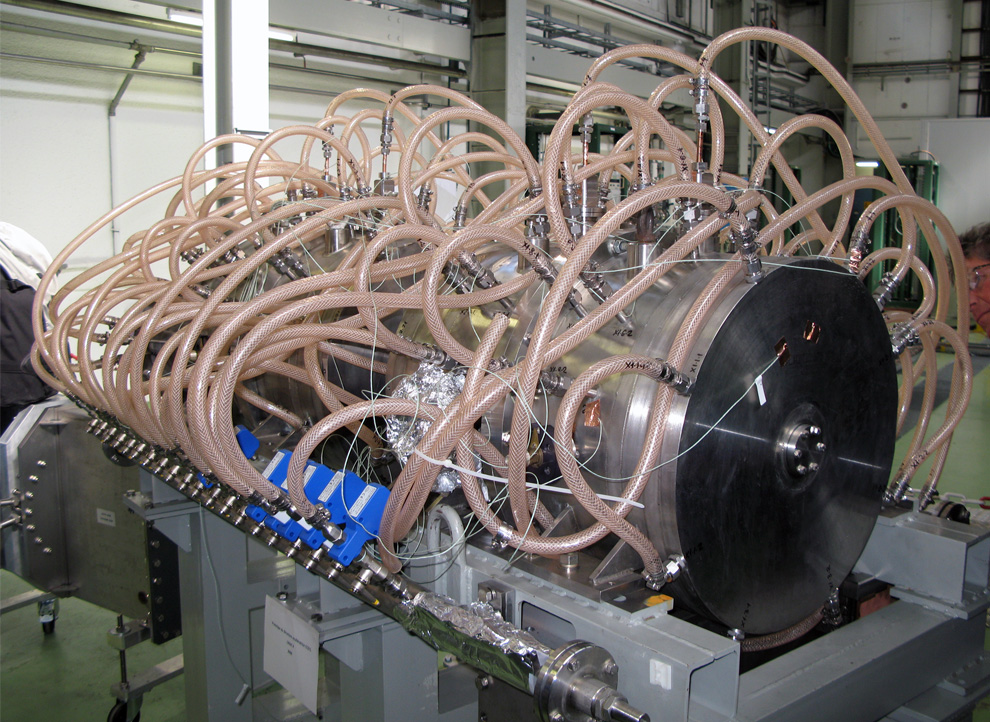
A radiofrequency chamber of the LHC. Radiofrequency chambers give a kick to the protons once per circuit to increase their speed. Original here. (Wikimedia user Rama / CC BY-SA)
How making money with music is finally changing

It's really not a very good graph (click to enlarge).
But, what it's saying is this...
We’ve all heard that the music business is changing, and here, from The Times Online, is a chart to prove it. The red line at the top is the revenue from sales of recorded music. The light green line below that is the revenue from live music. The dark green line below that, “PRS revenue,” is the revenue from royalties.
Basically there’s more and more money being spent on live shows and, consequently, more money going to artists themselves. At the same time the labels are being squeezed out of the equation because sales of recorded music are falling.
The Times adds:
It’s interesting too that, overall, industry revenues have grown in the period—though admittedly not by much—which arguably adds strength to the notion that, when the BPI releases its annual report claiming how much ‘the music industry’ has suffered from the growth in illegal file-sharing, what it perhaps should be saying is how much the record labels have suffered. For other people in the industry, not least artists, the future arguably holds more promise.
(via Good)
Yes guy!

The Dutch have done something innovative. They’re replacing the sales and ownership taxes on cars with a tax based on the amount people drive.
“Each vehicle will be equipped with a GPS device that tracks how many kilometres are driven and when and where. This data will be then be sent to a collection agency that will send out the bill,” the transport ministry said in a statement.
…Dutch motorists driving a standard family saloon will be charged 3 euro cents per kilometre (seven US cents per mile) in 2012. That would increase to 6.7 cents (16 US cents per mile) in 2018, according to the proposed law.
Here’s some quick math to translate. As recently as 2005, the average American had a commute of 33 miles. That’s about 53 kilometers. That would translate to a daily tax of 1.53 Euros, or $2.28. That adds up quickly. If this kind of tax were instituted in America, the average commuter would be paying an extra $11 each week. That’s more than $500 each year.
This kind of plan has been proposed here, too. It’s been talked about in Oregon and considered by Secretary LaHood. The nice thing about a mileage (or kilometer) tax is that it internalizes the some of the external costs of driving thereby encouraging people to drive less. It also links the money we use for infrastructure upkeep with the actual use of our roads and highways.
But a mileage tax, unlike a gas tax, doesn’t encourage people to drive cleaner cars. It adds a cost to driving based on the distance, not the carbon. A Tesla and a Hummer are taxed the same. The smarter plan—especially given the cost and privacy concerns associated with all of those GPS devices—might be to raise the gas tax or design a new one that’s a little more innovative than the current flat gas tax.
(copied basically exactly from Good)
Dandelion Salad
94 year old cook and great grandmother, Clara, recounts her childhood during the Great Depression as she prepares meals from the era. Learn how to make simple yet delicious dishes while listening to stories from the Great Depression.
From the Leaf Lady:
According to the USDA Bulletin #8, "Composition of Foods" (Haytowitz and Matthews 1984), dandelions rank in the top 4 green vegetables in overall nutritional value. Minnich, in "Gardening for Better Nutrition" ranks them, out of all vegetables, including grains, seeds and greens, as tied for 9th best. According to these data, dandelions are nature's richest green vegetable source of beta-carotene, from which Vitamin A is created, and the third richest source of Vitamin A of all foods, after cod-liver oil and beef liver! They also are particularly rich in fiber, potassium, iron, calcium, magnesium, phosphorus and the B vitamins, thiamine and riboflavin, and are a good source of protein.
These figures represent only those published by the USDA. Studies in Russia and Eastern Europe by Gerasimova, Racz, Vogel, and Marei (Hobbs 1985) indicate that dandelion is also rich in micronutrients such as copper, cobalt, zinc, boron, and molybdenum, as well as Vitamin D.
Much of what dandelions purportedly do in promoting good health could result from nutritional richness alone. Vogel considers the sodium in dandelions important in reducing inflammations of the liver. Gerasimova, the Russian chemist who analyzed the dandelion for, among other things, trace minerals, stated that "dandelion [is] an example of a harmonious combination of trace elements, vitamins and other biologically active substances in ratios optimal for a human organism" (Hobbs 1985).
Here's the raw nutritional value.
Clara's entire series is available on youtube (the Poorman's meal also looks great!).
(Via BoingBoing)
Andre Williams and The Sadies













Andre Williams (from Allmusic)
Zeffrey "Andre" Williams has worn many musical hats during his long career: recording artist, songwriter, producer, road manager, and so on. The Father of Rap was born November 1, 1936, in Chicago, IL, and was raised in a housing project by his mother, who died when Williams was six years old.
Doing his Fortune (records) stint, Williams kept busy playing the popular clubs in Detroit and other locales, including the Flamingo Club in Memphis, TN. His biggest solo hit, "Bacon Fat," occurred during a drive to Memphis' Flamingo Club. When he got back to Detroit he persuaded Devora Brown to book a session. Fortune's recording studio was in the back room of a record shop the Browns owned. "Bacon Fat" was Williams' third single for Fortune; he didn't even have the lyrics written, but hurried and did so on a napkin while Devora busied herself setting up the studio mikes.
Here's Bacon Fat:
Williams was still associating with Motown when he masterminded "Shake a Tail Feather" for the Five Dutones and "Twine Time" for Alvin Cash & the Crawlers, on George Leaner's Onederful Records in Chicago.
Williams now lives in Queens, NY, and is back active in the business of music. He performs at much better venues then he did during his Jail Bait years, and still dazzles audiences with his swagger and loud pimpish wardrobe. He released more albums in the '90s than he did during the first 40 years of his career, including Silky and Directly from the Streets. The Black Godfather and Fat Back & Corn Liquor followed in 2000.
Here's Andre and The Sadies in Chicago:
Thursday, November 19, 2009
First universal programmable quantum computer unveiled

... with an accuracy of only 79 per cent... The experimental device uses beryllium ions to store qubits in the way they spin while the laser-pulse quantum gates perform simple logic operations on the qubits. The trick to making a quantum logic gate is in designing a series of laser pulses that manipulate the beryllium ions in a way that processes information. Another laser then reads off the results of the calculations.
Monday, November 16, 2009
Dock Ellis' no-hitter - seriously?
http://www.huffingtonpost.com/2009/11/13/dock-ellis-lsd-no-hitter_n_357351.html
Ellis remained calm. The game would start late. Ample time for the acid to wear off. Then it struck him: doubleheader. The Pirates had a doubleheader. And he was pitching the first game. He had four hours to get to San Diego, warm up and pitch. If something didn't happen in the interim, Dock Philip Ellis, age 25, was about to enter a 50,000-seat stadium and throw a very small ball, very hard, for a very long time, without the benefit of being able to, you know, feel the thing.
Dock's box score (click to enlarge):

Google Wave
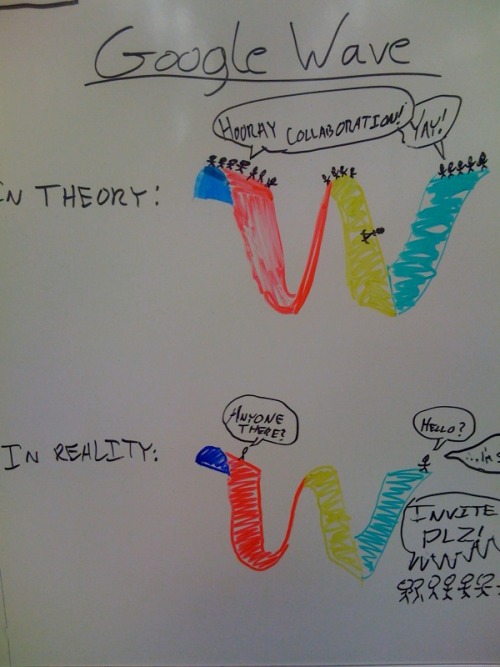
http://www.frkncngz.com/post/243811028









